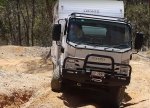Ultimark
Active member
I wondered about fixed mounting of a box or tray directly to chassis rails around 50 years ago, it was pretty new to me then but I had only been driving 3 tonne trucks over paddocks with probably around 1½ tonne on the tray at the most; basically things didn't flex and wheels came off the ground. Then I was introduced to military trucks which had unbelievable flex and I learnt a bit about having the load carrying part able to move in relation to the chassis rails.
Fast forward 50 years, I'm back in trucks and have sort of come full circle. I have a single cab chassis Isuzu NPS 300, current model. The tray on the back is spring mounted with four springs either side. We have a slide on camper bolted directly to the tray in four points, essentially the tray and camper stay flat, although with chassis flex there is movement of the tray and it's load in unison. So far and with some considerable chassis flex and reasonably good axle articulation, not a squeak, whimper or sign of twist in the camper. The camper by the way, is 11 years old as it was on another vehicle; it's been on the NPS for a year now.
The accompanying pictures are lifted from a YouTube video done by Robert Pepper; L2S-FBC. It was a comparison between a Ford ute and our Isuzu light truck.
In the first picture the chassis is certainly twisted, the front and rear axles are diametrically opposed and pretty much on their limit of articulation. The cabin is going one way, essentially being twisted by the front axle, while the rear of the chassis rails are twisted the other way by the rear axle. In-between is the tray and camper pretty much dead flat, although they too were moving around. But they weren't flexing, which, as far as I'm concerned, is good.
In the second picture only the front of the chassis is noticeably twisting. This can be seen by looking at the cabin in relation to the rest of the tray and its load, one can see that the rear axle is dead in alignment with the rear of the chassis rails. I'm actually watching the right rear wheel in anticipation of applying throttle just before the right rear wheel kisses the mound. I was able to slide the rear axle around the mound and away we went.


Fast forward 50 years, I'm back in trucks and have sort of come full circle. I have a single cab chassis Isuzu NPS 300, current model. The tray on the back is spring mounted with four springs either side. We have a slide on camper bolted directly to the tray in four points, essentially the tray and camper stay flat, although with chassis flex there is movement of the tray and it's load in unison. So far and with some considerable chassis flex and reasonably good axle articulation, not a squeak, whimper or sign of twist in the camper. The camper by the way, is 11 years old as it was on another vehicle; it's been on the NPS for a year now.
The accompanying pictures are lifted from a YouTube video done by Robert Pepper; L2S-FBC. It was a comparison between a Ford ute and our Isuzu light truck.
In the first picture the chassis is certainly twisted, the front and rear axles are diametrically opposed and pretty much on their limit of articulation. The cabin is going one way, essentially being twisted by the front axle, while the rear of the chassis rails are twisted the other way by the rear axle. In-between is the tray and camper pretty much dead flat, although they too were moving around. But they weren't flexing, which, as far as I'm concerned, is good.
In the second picture only the front of the chassis is noticeably twisting. This can be seen by looking at the cabin in relation to the rest of the tray and its load, one can see that the rear axle is dead in alignment with the rear of the chassis rails. I'm actually watching the right rear wheel in anticipation of applying throttle just before the right rear wheel kisses the mound. I was able to slide the rear axle around the mound and away we went.


